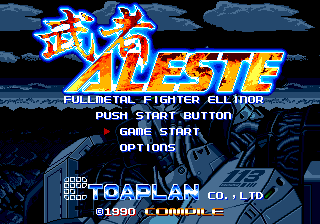Difference between revisions of "M.U.S.H.A."
From Sega Retro
| Line 36: | Line 36: | ||
| ?? | | ?? | ||
| colspan="2" align="center"|Yu-Ichi Toyama | | colspan="2" align="center"|Yu-Ichi Toyama | ||
| + | |- | ||
| + | | Z80-side Programmer | ||
| + | | ?? | ||
| + | | colspan="2" align="center"|Kyo-Ra Yumi | ||
|} | |} | ||
| − | |||
==Physical Scans== | ==Physical Scans== | ||
Revision as of 11:28, 24 March 2011
This short article is in need of work. You can help Sega Retro by adding to it.
| Musha Aleste: Full Metal Fighter Ellinor/M.U.S.H.A. |
|---|
| System(s): Sega Mega Drive, Virtual Console |
| Publisher: Toaplan (US Seismic) |
| Developer: Compile |
| Genre: Shoot-'em-Up |
|
CERO
Missing Parameter! |
Musha Aleste: Full Metal Fighter Ellinor (武者アレスタ), known in the US as M.U.S.H.A.: Metallic Uniframe Super Hybrid Armor, is a 1990 shoot-'em-up developed by Compile for the Sega Mega Drive and published in Japan by Toaplan and in the US by Seismic (there was no European release). It is the only Mega Drive game in Compile's Aleste series of shoot-'em-ups and the first released-overseas game in the series to not use the Power Strike name.
Dire51, a supercomputer crafted to control a space colony, goes rogue and sends its attack robots, led by mech Big Asia., to destroy mankind. A team of fighters in giant mechs try to stop it, but all but one, Ellinor (Terri in the US version), are killed, leaving Ellinor to save humanity from destruction on his own.
![]() shoots; there is rapidfire, but there will be a gap every few shots. There are two means of powering up. First, scattered throughout the levels are pods containing small vertical bars that flash red, green, and blue. Shooting at the pods will have them spit out the vertical bars, which will power up your main weapon. Second, some enemies produce larger, colored powerup balls called "P-chips." P-chips cause the mech to change color and adapt a subweapon which is fired with
shoots; there is rapidfire, but there will be a gap every few shots. There are two means of powering up. First, scattered throughout the levels are pods containing small vertical bars that flash red, green, and blue. Shooting at the pods will have them spit out the vertical bars, which will power up your main weapon. Second, some enemies produce larger, colored powerup balls called "P-chips." P-chips cause the mech to change color and adapt a subweapon which is fired with ![]() . P-chip abilities can be upgraded with further P-chips of the same color; taking a different color P-chip will replace whatever P-chip power the player already has. If the player gets hit, he will first lose his subweapon, then one life.
. P-chip abilities can be upgraded with further P-chips of the same color; taking a different color P-chip will replace whatever P-chip power the player already has. If the player gets hit, he will first lose his subweapon, then one life.
Production Credits
For whatever reason, some nicknames were changed between the Japanese and American releases. The actual personnel are the same:
| Role | Real Name | JP Credit | US Credit |
|---|---|---|---|
| Game Design | Compile | ||
| Supervisor | Jemini Hirono | ||
| 68000-side Programmer | ?? | Yu-Ichi Toyama | |
| Z80-side Programmer | ?? | Kyo-Ra Yumi | |
Physical Scans
Mega Drive Version
External Links
| Aleste/Power Strike games for Sega systems/published by Sega | |
|---|---|
| Power Strike (1988) | Power Strike II (1993) | |
| M.U.S.H.A. (1990) | |
| GG Aleste (1991) | Power Strike II (1993) | GG Aleste 3 (2020) | |
| Robo Aleste (1992) | |
| M.U.S.H.A. (2008) | |
| Aleste Collection (2020) | |
| Aleste-related media | |
| Aleste Collection: Music Album (2022) | |


